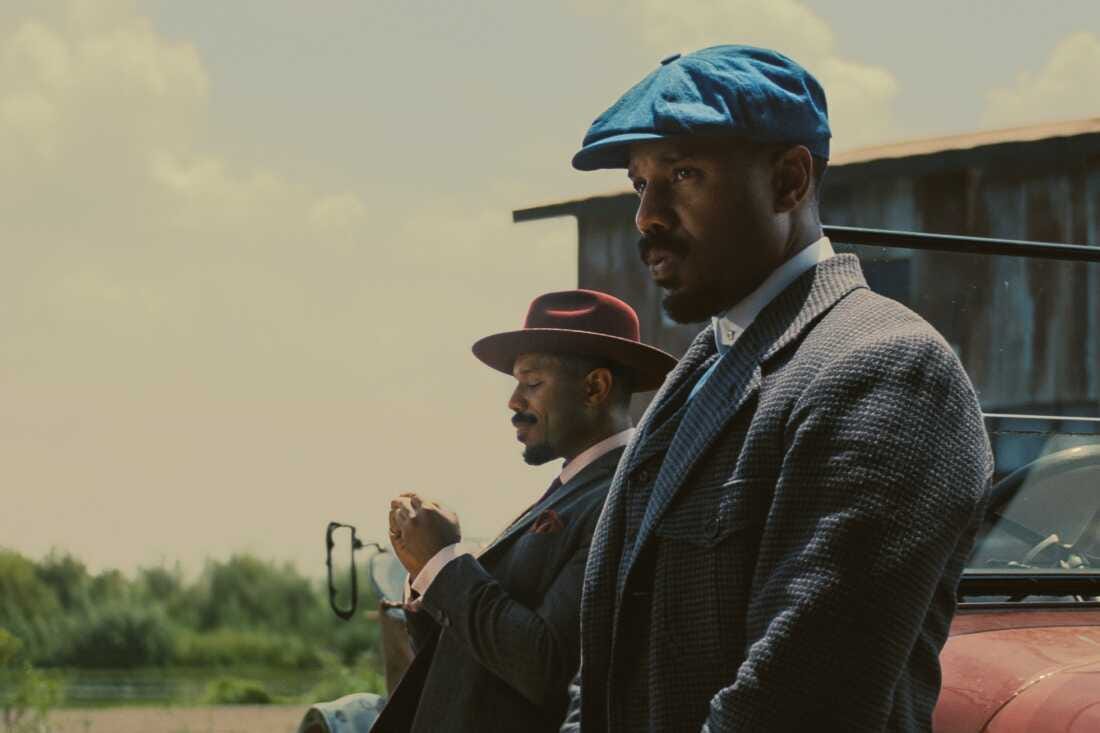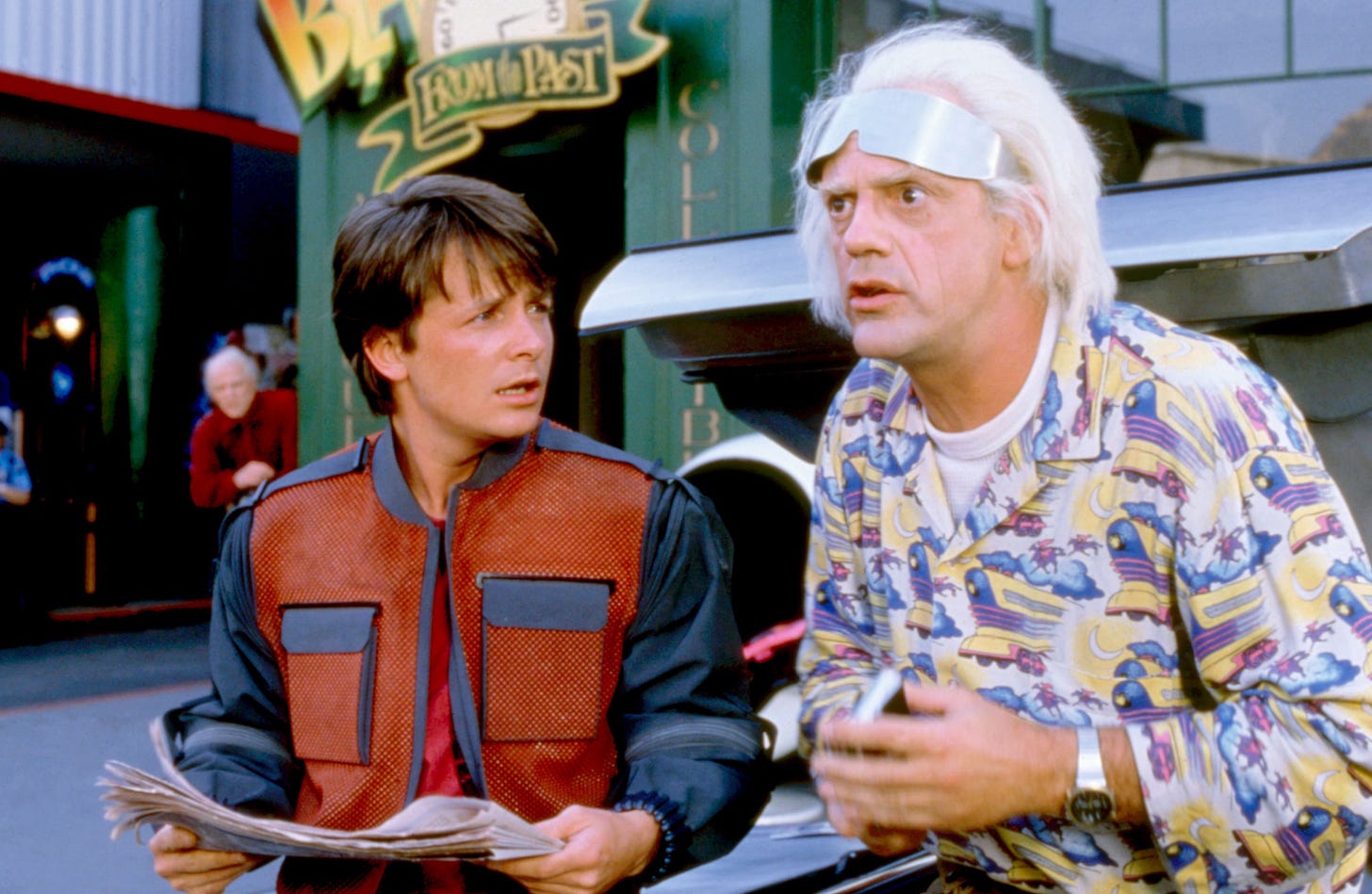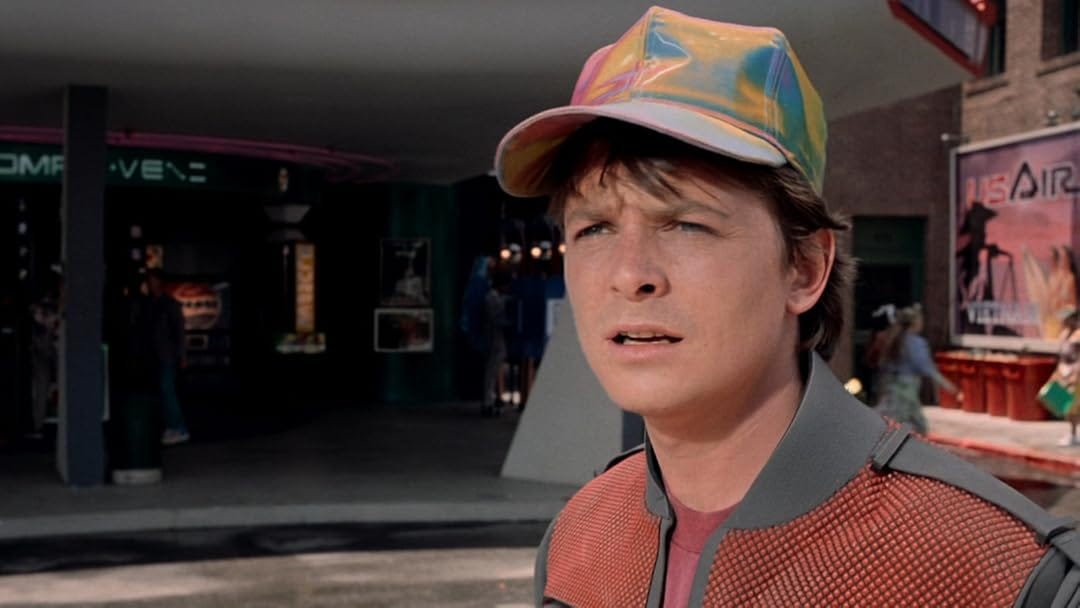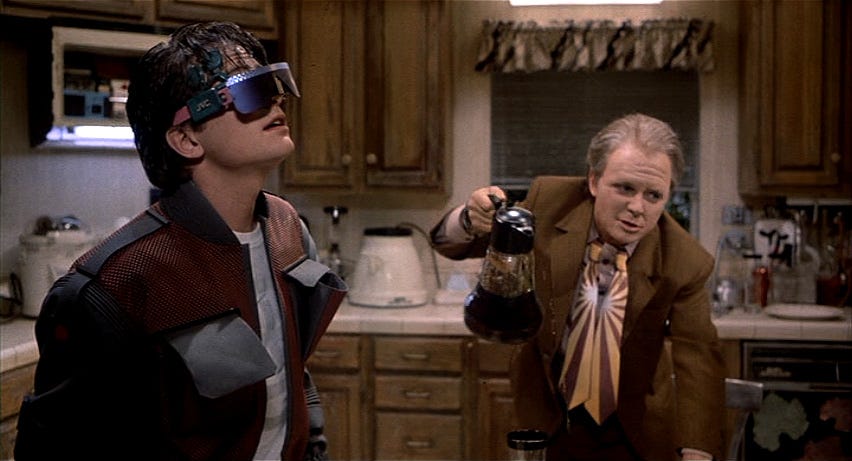Weaponizing Studio Hypocrisy with 'Back to the Future Part II'
For the good of mankind, of course
I was approximately twelve years old when my folks introduced me to Robert Zemeckis’ Back to the Future films, though I was only shown the original film and Part III, as they deemed Part II to be too inappropriate for me at the time.1 This, at a glance, seemed just as well, because in the fifteen years since then, I’ve understood that Part II is considered the worst of the bunch by a not-insignificant distance.
And there’s that sentiment I’ve grown to despise; “the worst of the bunch,” as though defining our rhetoric by the lack of something is a good use of our time. With the new film criticism, we’ll move away from nebulous pillars like praise and denigration and replace them with art communication and constructivity. Ego belongs in the past, ostensibly the year 1885.
Anyway, I’m going to explain to you all why Back to the Future Part II is actually a metatextual masterwork, and why Zemeckis might actually be a secret time traveller himself, since he was sick of the current state of filmmaking long before we ever had to bear the brunt of it.
So much so, in fact, that he made a whole sequel about this very plight.
Now, understanding the cheeky satire of Part II more-or-less requires a short history lesson on the development of the original film.
Nowadays, Back to the Future — complete with its sharp, rapid-fire, ironic comedic identity2 and hearty storytelling emphasis — is regarded as one of the sci-fi greats, but back in 1980, it was just another commercially unviable script in the eyes of the studio heads. The project was rejected over forty (40!) different times, with many suits believing that the honesty at the center of Back to the Future’s narrative and humour wouldn’t play well in a market defined by raunch comedy. Without Spielberg’s backing, it may have never gotten off the ground.
Even during production, the executives remained unconvinced by it, with one going so far as to suggest a title change from Back to the Future to Space Man from Pluto.
Needless to say, Zemeckis and his creative partner Bob Gale had none too few reasons to be soured on these people.
Of course, Back to the Future would go on to turn the highest profit at the 1985 box office, nab an Oscar from four nominations, and proceed to endure decade after decade near the front of the American pop culture pantheon. And so, just by coincidence of course, Back to the Future is immediately greenlit for a sequel after spending however many moons being a laughingstock of Hollywood boardrooms.
Zemeckis — no doubt smelling the ignorance and hypocrisy radiating off of these suits — is warned that Universal will pursue this sequel without his involvement if need be. So he and Gale agree to give them a sequel, and by ginger, they’re going to make sure that their disdain for this particular sector/trajectory of the film industry is going to be written all over it.
When watching Part II, it’s paramount to pay attention to how Zemeckis presents the media in this world, starting from the following lines:
DOC: In exactly two minutes, you go around the corner, into the “Cafe 80’s.”
MARTY: Cafe 80’s?
DOC: It’s one of those nostalgia places, but not done very well.
A nostalgia place that’s not done very well? Isn’t that the exact game that Hollywood suits have been playing for decades now? Humming and hawing about anything even remotely creative, only to practically lust after that same thing when the package of the story (not the story itself!) turns out to be commercially lucrative? A package that they think people will recognize and buy (meaning, in essence, they’re trying to contrive a nostalgic reaction out of these people with nothing more than set dressing, that iconic logo, and the mugs of Michael J. Fox and Christopher Lloyd)?
It sure is,3 and Zemeckis — having been subject to this very bullshit — goes straight for the jugular with Part II as his mock-happy weapon.
OLD BIFF TANNEN: Manure? Ha, I remember that.
I mean, for crying out loud, no sooner does Marty begin his trek to Cafe 80s does he stumble upon a glitzy, 4D advertisement for Jaws 19. Zemeckis knows exactly where the film industry is headed at this point in time after his experience with getting Back to the Future made and then hijacked, and while he’s powerless to prevent the milking of his sci-fi maverick-turned-tragic cash cow, at least he can still utilize his canon to lampoon this dystopian development as it happens before our very eyes.
His predictions/satirical potshots don’t end at the studio boardroom level, though — he also takes time to warn us about what’s in store for visual media as a whole. Namely, a tragic cultural shift that begins to devalue art and film in favour of content and passive, non-committal consumption:
When Marty McFly Jr. arrives home to watch some television (which is displaying a screensaver of a painting when he walks into the living room), what does he do?
He says “art off,” and then requests six different channels — not even programs or specific media — to watch simultaneously on the same screen. There is nothing subtle about this.
And throughout, Zemeckis and Gale hit a lot of the same beats from Back to the Future (Marty getting chased by Griff, Marty waking up and believing he had a nightmare, what have you) while mirthfully extinguishing the ironic crux of its comedy. In a conventional context, this is a big comedic no-no, but here in Part II, it purposefully calls attention to what we’re actually watching here — the artistic merits of Back to the Future being torn to shreds so as to leave a surface-level husk behind (which is, again, the only piece of Back to the Future that the Hollywood suits are interested in):
When Biff and his older self are sitting in the car, Biff rhymes off his famous quip “Why don’t you make like a tree and get out of here,” which has always been funny to us audiences because it’s obviously supposed to be “leave” instead of “get out of here,” but Biff is too oblivious to understand that.
But then Old Biff smacks him on the head and tells him exactly that, which completely deflates the tension in the ironic comedic framework. It’s blatant self-sabotage in service of publicizing what’s effectively a case of Back to the Future being held hostage by these studio heads.
Zemeckis and Gale save the best of these tricks for last, though.
The final act of the film takes place in 1955; the same version of 1955 that the bulk of the original Back to the Future takes place in. You can probably see where this is going.
Indeed, pay attention to how many times Marty stops to watch the events of the original Back to the Future play out as he tries to get the sports almanac from Biff, and then consider how, at this point, Part II has blown right past merely referencing its predecessor, and is now literally inhabiting and sharing the exact same diegetic space as it, while showing scenes from that very predecessor that audiences are apparently so nostalgic about.
And to seal the deal, the film ends with a literal trailer — complete with a long ensemble of scenes both pivotal and high-octane — for Back to the Future Part III, which itself is alluded to throughout Part II with its plethora of Western references.
In other words, Part II isn’t just callbacks and brand nostalgia — it also literally transforms its final act into an advertisement for what is now, regrettably, the franchise of Back to the Future. It’s 100-ish minutes of Zemeckis and Gale caricaturizing the very enterprise that’s backing Part II (and pop culture on the whole) into this corner of gross commercialization.4
And, unfortunately, they were more prophetic than they perhaps realized.
Film criticism is in a similar corner, I think. Just as film studios use Back to the Future and other IPs as coats of paint to decorate a vapid product (most of which aren’t so lucky to have creatives like Zemeckis and Gale to salvage them so brazenly), many modern film critics are using films to decorate a vapid opinion. Both of these things, in place of the substance that’s actually responsible for creating the culture that owes itself to real films and real criticism.
We critics do ourselves very few favours by centering our criticism on our abstract, unreplicable experiences with the art, and subsequently telling people what they should and should not go watch based on that. Not only does this invite the sentiment that we’re snobbish and out-of-touch, but it confines us to a position of irrelevance that we pretend isn’t there.
How can we possibly quantify our relevance beyond a righteous ghost of cinematic literacy when countless instances of shiny, vapid slop pulls the audiences it does in spite of negative critical reception?
Perhaps, then, it’s not our approval or dismissal we should be putting on the table as critics, but the ways in which we can equip our readers to watch, appreciate, and read film, all while offering a constructive attitude that will help guide the films of tomorrow.
Example: You will probably never see me write about Back to the Future Part III, because I don’t have anything to say about it. From my vantage point, it’s a total nothing-burger that Zemeckis and Gale seemingly just wanted to pull over the finish line and be done with. I don’t personally think it’s worth watching.
But what does anyone actually gain from me saying something like that? Maybe I’m missing certain nuances because of my relative lack of literacy in the Western genre, thus rendering me unable to communicate whatever substance may or may not permeate Part III. Maybe another critic boasts such literacy and can communicate that instead. I’d much rather read what they’d have to say than dedicate my own however-many words to a piece that ultimately offers nothing more than “I saw no value in this.”
And should our North Star, as art communicators, not be to find value in something? Not to contrive value for the sake of #goodvibes, nor to self-servingly insist upon our tastes as an indicator of the film’s value, but to say things about a film that the reader can reckon with just as tangibly as they can with the film itself? To help expand one’s artistic and creative skill of watching a movie, and thereby reinforce the viewer — in all of their singularity — as a fundamental aspect of a film’s collaborative nature? To free the viewer of skepticism and teach them curiosity?
Then, if we come across something like Rebel Moon or The Electric State — two examples of films that are entirely void of honest, concrete value — there will simply be nothing to talk about, and we save ourselves from creating culture out of things that don’t deserve a place in it (or, more aptly, things that don’t have anything to create culture out of).
And if a critic comes along claiming that Rebel Moon or The Electric State is a masterpiece? Well, they’d owe us the granddaddy of all interpretations to back that one up. Personally, I would love to see good film criticism about either of those films, because I have no idea what it could even look like.
This way, we predicate the craft of criticism on imagination rather than taste. It simply wouldn’t be enough for critics to have a thumbs-up-or-down opinion on a film; they would actually need to have something worth saying about it.
Moreover, it would turn film criticism into an event unto itself. Imagine: a film like Sinners drops, and then you find out that a film critic plans to write something about it. All of a sudden, you’re anticipating a brand new way to engage with Sinners on top of the way that you’re already going to engage (or already have engaged) with it.
And if you’re one of those people who wasn’t clued in to Sinners — a film that, whether you liked it or not, boasts an undeniably dense creative nutrition profile — perhaps you decide to check it out because of all these film critics that have so much to say about it. Suddenly, critics are creating culture exclusively with the films that deserve to have culture created out of them, rather than wasting their time on the latest Rebel Moon pile-on.

Anyhow, today’s piece of criticism wound up running shorter than what’s become my usual, and I figured we were overdue for a beefy pontification on the new film criticism here. I haven’t ruled out writing a manifesto, but I’ve neither the time nor the crayons for that at the moment, so you’ll just have to settle with feeling it emanate from the mortal essence of this blog.
To finish things off here, I wanted to tease that, two or three weeks from now, I’ll be introducing a brand new film criticism series that I’ll be pursuing here on The Treatment in tandem with my usual posts. It will still largely involve the same type of film criticism that you always see from me, but with a special added dimension that I’ve only utilized sparingly up until now (and by sparingly, I mean I’ve used it in exactly one other post on this blog). Stay tuned!
I was not popular in school.
I talk about the nuances of comedic identity in my American Fiction piece.
Source: I live in the world.
Which is, of course, different from filmmakers who actively pursue an idea for a sequel that has genuine narrative nutrition and is additive to the cinematic/storytelling zeitgeist.







You're our film critic savior!!! Looking forward to what you have in store for us x
It's always annoying when I read reviews from critics who very very clearly didn't get a certain movie. What bothers me is that they act like it's a sin to not "get" a movie. If you don't get it, write about WHY you don't get it, and what that says about you and your lived experience. Let the movie take you wherever it takes you, and embrace the fact that it might be an unconventional direction.
Or, y'know, be funny. I can't square the idea of someone writing about a comedy when they themselves aren't at all funny. That just doesn't make sense to me.
Fromtheyardtothearthouse.substack.com